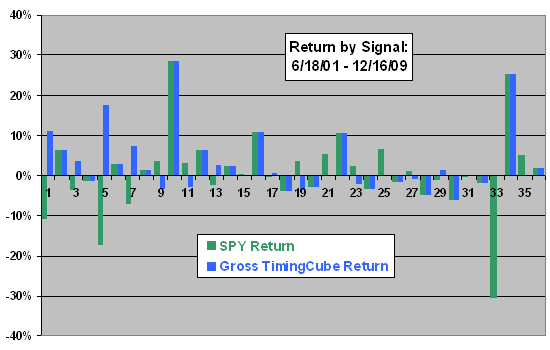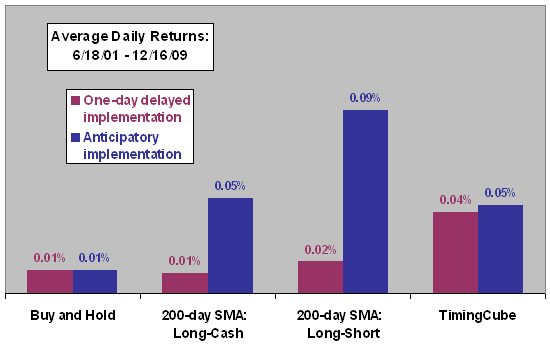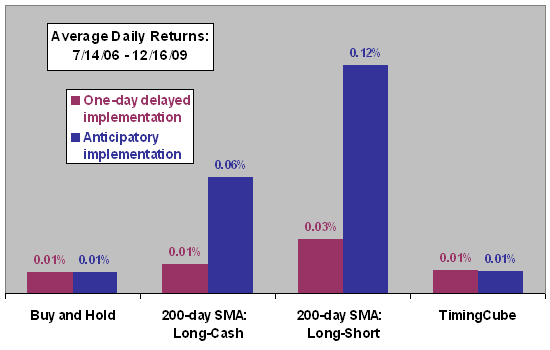A reader requested a review of the TimingCube market timing advisory service, which relies “on the Trend Timing Model to detect major trend changes in the broad market and to issue clear, definitive Buy and Sell signals, on average three to five times per year.” The offeror provides a history of “all ‘live’ TimingCube signals since June 18, 2001.” Using this record of 36 signals, daily S&P Depository Receipts (SPY) closes adjusted for dividends over the period 6/17/01 through 12/16/09 and daily closes of the S&P 500 Index over the period 8/30/00 through 12/16/09, we find that:
The following chart compares the gross returns from trading SPY based on the 36 live TimingCube signals to those for buying and holding SPY during the same intervals. Calculations assume implementation of each TimingCube signal at the close on the day after issuance. TimingCube returns do not include trading frictions or costs of carrying short positions.
Over the sample period, the TimingCube signals successfully reverse or avoid the most dramatic SPY losses but otherwise are not dramatically different from buying and holding SPY. Some metrics of note:
- Overall, the average gross return per signal based on TimingCube signals (buy-and-hold) is 2.7% (0.7%).
- During bullish market conditions, the average gross return per signal based on TimingCube signals (buy-and-hold) is 3.0% (3.7%).
- During bearish market conditions, the average gross return per signal based on TimingCube signals (buy-and-hold) is 2.3% (-5.8%).
In general, it appears that the TimingCube signals substantially boost (modestly depress) returns during bearish (bullish) market conditions. It is therefore favorable to TimingCube to start the sample period during bear market conditions.
Using opening prices for TimingCube transactions (since signals are available after the prior close but before the open) might affect returns slightly. Applying trading frictions and shorting costs would reduce TimingCube returns, depending on account size and specific broker fees.
Do these results mean that TimingCube is worth its price?

The next chart compares average daily returns during 6/18/01 through 12/16/09 for timing of SPY based on TimingCube signals and three simple (and free) alternatives:
- Buy and hold SPY.
- Go long SPY (to cash) when the S&P 500 Index crosses above (below) its 200-day simple moving average (200-day SMA: Long-Cash).
- Go long (short) SPY when the S&P 500 Index crosses above (below) its 200-day SMA (200-day SMA: Long-Short).
Alternatives 2 and 3 each generate 72 trading signals over the sample period. Since the signals derive from market closes, we first implement each alternative at the following market close (one-day delayed implementation). Because the use of 200-day SMA crossovers by many investors may move the market, we also test a variation with crossovers anticipated just before the close and implemented at the same close (anticipatory implementation). For comparison, we test similar prior-close anticipation of TimingCube signals.
For each change in position for 200-day SMA signals and TimingCube signals, we assume a rough trading friction of 0.25%. We do not account for costs of holding short positions, which represent 44% of trading days for alternative 3 above and 28% of trading days for TimingCube signals.
Results suggest that a nimble investor may be able to out-time TimingCube by closely monitoring and “front-running” S&P 500 Index closing 200-day SMA crossovers. However, results also suggest that returns for 200-day SMA crossover signals are fragile with respect to exact implementation date, while TimingCube signals are not.
Incorporation of shorting costs would reduce 200-day SMA: Long-Short returns and TimingCube returns, the former more than the latter. More precise assumptions on trading frictions would favor 200-day SMA: Long-Cash over both 200-day SMA Long-Short and TimingCube, and TimingCube over 200-day SMA: Long-Short.

The above analyses assume that the live TimingCube trade signal data is accurate and complete as presented. The sample of signals is fairly small for the types of analyses used, especially given the dependence of TimingCube outperformance on the relative frequency of bull and bear market conditions.
The TimingCube disclaimer states:
“TimingCube does not guarantee or warrant the quality, accuracy, completeness, timeliness, appropriateness or suitability of the Information or of any product or services referenced on the Site. TimingCube assumes no obligation to update the Information or advise on further developments concerning topics mentioned. …TimingCube IS PROVIDING THIS SITE AND THE INFORMATION ON AN “AS IS” BASIS AND MAKES NO REPRESENTATIONS OR WARRANTIES OF ANY KIND WHATSOEVER WITH RESPECT TO THE SITE OR THE INFORMATION OR WITH RESPECT TO THE USE OR SUITABILITY OF THE SITE OR THE INFORMATION FOR ANY PURPOSE. …TimingCube disclaims all warranties, representations and conditions regarding the Site and the Information, including, without limiting the generality of the foregoing, all implied warranties and conditions of merchantability, fitness for a particular purpose…”
In summary, evidence from simple tests indicates that the TimingCube market timing advisory service may outperform a buy-and-hold strategy over periods that include bear market conditions, but that nimble use of 200-day simple moving average crossover signals may do as well or better than TimingCube signals.
See Guru Grades for links to evaluations of the commentaries and advice of other investing experts.
Reader Michael Stokes of the MarketSci Blog noted in an email that TimingCube implemented a revision to their timing model in July 2006. TimingCube states that the “current timing Model…went into effect on July 14, 2006.” How has TimingCube’s model done since that revision?
The following chart repeats the SPY-based analysis used to generate the second chart above for the subperiod 7/14/06 through 12/16/09. Results based on average daily returns show that TimingCube has not outperformed a buy-and-hold strategy and has likely underperformed 200-day SMA crossover signals during this subperiod, despite avoiding the steep drop in the market from late 2008 through early 2009.
However, TimingCube has a standard deviation of daily returns for this subperiod of 0.94%, compared to 1.77% for buy-and-hold. The 200-day SMA: Long-Cash has an even lower 0.64% standard deviation of daily returns.

Another reader commented: “I subscribed to TimingCube for a couple of years. They changed the system more than once and then hid their actual results. Also, the web site was not even created until 10/31/01, so signals before then are bogus. When their system went south, they started new services. When those went south, they changed those as well. I think MarketWatch did a piece on them. Not good results.”
Your recollection of TimingCube service changes may be correct, but the articles discovered via a search of “TimingCube” at MarketWatch are favorable:
“Crash of 2008 Survivor is Bullish”: “Over the past 12 months [TimingCube is] up a remarkable 29.18% by Hulbert Financial Digest count, compared to a loss of 20.03% for the dividend-reinvested Wilshire 5000 Total Stock Market Index. Impressively, TimingCube also caught this year’s bounce-back. Over the year to date through July, the letter is up 33.3% versus 12.5% for the total return Wilshire 5000. And TimingCube’s success has been sustained for some time. Over the past three years, the letter has achieved a 5.19% annualized gain, versus negative 5.78% annualized for the total return Wilshire 5000. Over the past five years, the letter has achieved a 3.5% annualized gain against a 0.63% annualized gain for the total return Wilshire 5000.”
“Black-box Letter Still Bullish on Stocks”: “Over the past 12 months…TimingCube is up 44.8% by Hulbert Financial Digest count, compared to negative 6.43% for the dividend-reinvested Wilshire 5000 Total Stock Market Index. And this success is sustained. Over the past three years, the letter is up an annualized 6.96% against negative 4.83% annualized for the total return Wilshire 5000. Since April 2003, when the HFD began following TimingCube, it’s up 11.1% annualized versus 5.4% annualized for the total return Wilshire 5000.”
The Hulbert Financial Digest cumulative return measurement approach is very sensitive to measurement start and stop dates, more so than average return over many fixed intervals (days, months, years). Lucky starts (arguably prevalent due to survivorship bias) can dominate results for many years. Also, the reporting periods described in the above quotes are fairly short for measuring the performance of a service like that offered by TimingCube. The Hulbert Financial Digest results do not mean that TimingCube signals outperform 200-day SMA signals as described above.
The performance of a market timing advisory service, even if its signals are random, depends substantially on the frequency and severity of bear market conditions. Even random timing signals, by sometimes specifying cash or short positions, will outperform buy-and-hold when the market is declining. The media may have a tendency to pay more attention to market timers during bear markets, when they tend to have a “random” performance edge.
A reader followed up: “TimingCube’s home page claims a 37% annualized return. In prior years, they advertised 100%+ returns. For the first year I followed them (2003), they did great. I told everyone about it. Their subsequent failure starting in 2004 though has taught me a lesson. You have to give a system two full years at least to see if will work. I wish I had done that. Every single person to whom I recommended TimingCube has left them. If you look at TimingCube’s results page, you will see pure fiction. These are not the actual signals they put out, but instead the ‘revised’ signals that they backtested after the system failed a few times. I am surprised they are still in business. The SEC doesn’t respond to complaints very well. Why? There are lots of TimingCubes out there. It would be like reporting a dishonest used car salesman… Dishonesty and fraud is what TimingCube is about. …I wish you or someone would dig a little deeper and expose guys like this who misrepresent their results.”
Presentation of backtested results, with trading frictions excluded, is common in marketing copy among informational services like TimingCube. It takes a degree of sophistication to understand the implications. The SEC apparently assumes that investors have this degree of sophistication, so disclosures and disclaimers (though generally much less prominent than marketing claims) protect the offerors.
Over and over again, CXOadvisory.com, in both general commentaries and specific reviews, cautions about the bias involved in hypothetical backtests and about the potentially material impacts of trading frictions on returns (and sometimes the incredible extrapolations of very high returns). Over and over again, reviews point out that the disclaimers made by informational services conflict with the representations in their marketing copy. See Investing Demons for a comprehensive synthesis.
It is difficult to understand why people ignore the flat disclaimers of usefulness and rigid disavowals of any warranty these services include on their sites. Would these same people buy cars or appliances with no performance guarantee (no warranty)?
The SEC will act on hard evidence of intentional deception. See “What About Dan Murphy?” and “Safe with Martin Weiss?” for examples.
Specifically, the above analysis uses older (and less prominent) trade data that TimingCube claims is not backtesting but live signals. Findings appear not to conflict with those cited in MarketWatch to Hulbert Financial Digest, which employs real-time testing with trading frictions. The CXOadvisory.com review also quotes TimingCube‘s disclaimer that their service is of any use and flat denial of warranty.
Note that, depending on the frequency with which a trading system generates trading signals, the duration of the signals and any implicit relationship between the system and market/economic conditions, statistical confidence (to the extent such confidence is achievable at all) may require sample periods much longer than two years.
Note also the following from Peter Brimelow in MarketWatch (12/23/10): “The Terrible Ten for 2010… TimingCube, F. Minssieux: -9.0%… Still, TimingCube is up 3.03% annualized over the last three years.”